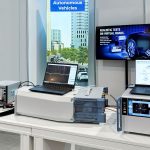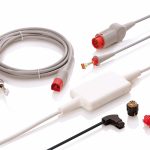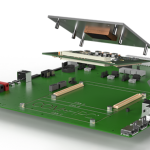Traditionally, testing of new automotive sensors is conducted at predetermined stages or at the end of the design process. However, the proliferation of sensors and the increasing complexity of sensor fusion software demand a shift to continuous testing, verification and validation. Here, using the right tools and development methods will shorten time to market, save money in avoiding expensive road testing and, ultimately, deliver a product that meets or exceeds the engineering application expectations.
Automotive electronics complexities
A new approach to vehicle electronics design is needed as systems and operating environments grow ever more complex. Inside the vehicle, systems and subsystems are proliferating as manufacturers respond to demands for added functionalities – from infotainment and environmental controls to navigation and assisted driving. We are seeing a proliferation of inputs throughout the vehicle, which must be collected, processed, interpreted and combined to create the best model for driving conditions and vehicle performance.
But even though adding all these electronic components into the modern vehicle to improve driving and comfort, there’s an underlying problem that it’s just now beginning to surface – that of all of these components interacting in unexpected ways, potentially causing drops in performance and even failure. Complex systems are also more vulnerable to cybersecurity threats as attackers use external signals including GNSS, Wi-Fi, radar and V2X to implant malware.
In such a complex ecosystem of many diverse electronic components, it becomes increasingly difficult to test in a meaningful way that ensures thoroughness, repeatability and transparency whilst achieving cost efficiency, flexibility and long-term adaptability.
To address this problem, automotive electronics engineers need a new approach to testing.
Not the sum of its parts
In design and engineering one common assumption is that the system as a whole will function as expected based on the aggregate performance of its components; sadly, practice shows otherwise.
Components must coexist on a shared communication system, leading to potential problems with out-of-band interference, power draw and conflicting sensor outputs.
Within the software industry, components must function in harmony to avoid everything from signal collision and system overloads to data corruption and security breaches. Software developed in a fixed, programmatic fashion is prone to failure and post-delivery patching, a problem that led software engineers to develop a new, more flexible way of working, a methodology which recognises that complexity itself was becoming a design constraint.
Agile methodology – popularised over 20 years ago and now widely used in the development of complex software applications – is a continuous process that involves breaking a project into phases. In each phase developers iterate through planning, execution and evaluation, and subdivide it into additional stages to address new challenges as they are discovered. By incorporating testing into the development process, mistakes are captured early, and developers can abandon or modify their approach to a problem before it becomes in too deep into the project.
Systems and components
There are two inter-related challenges in automotive electronic system design and test which taken together give rise to a third challenge.
Firstly, there is the testing of components in isolation. How do you provide realistic inputs and measure outputs without road testing?
Road testing is possible, but it’s time-consuming, non-repeatable and non-controllable. Test rigs are a well-established method for testing individual components, but the challenge is creating as realistic a test environment for them as possible, with high-fidelity signals that replicate the real-world signal environment challenges.
Then there are the changing demands of different stakeholder groups, including vehicle designers, regulators and consumers, and the sheer technical system complexity that they require.
Finally, and related to the previous two challenges, we tend to treat components and systems as distinct stages in the design process, but the lines are becoming increasingly blurred.
Traditionally, components are designed and tested for specific functionality and certified for specific standards. Then these components are packaged on the assumption that they will perform within a system as expected.
However, as the industry has learned repeatedly to its detriment, unexpected performance issues that are not identified in testing can lead to significant delays or even product recalls, as issues are identified in production or, even worse, when at the customer.
Integrated testing
Then the order of complexity grows, since systems tend to integrate hardware and software from various suppliers. To achieve seamless operation, engineers need equipment to build and test iteratively, with each iteration being used to test cross-functionality and stability, eventually leading to testing the system as a whole.
With the average vehicle having at least 150 electronic control units, with continuous test, problems can be identified early to create a solid foundation on which to build subsequent phases. Hence, the backbone of continuous testing is the right test equipment. Key considerations can be classified under capabilities and performance. A broad range of capabilities means more functions can be tested in more scenarios and with a greater degree of realism than otherwise possible. This will guarantee that any errors or flaws are caused by the device under test and not the test equipment itself. Precision, consistency and application-specific parameters, such as latency for hardware-in-the-loop testing, are all critical to achieving this.
Real-world road tests
We believe that real-world road tests are not an effective way to test during development. Real-world testing has its place, but it is most effective at the end of the process, after all the engineering problems have been resolved. With the right test equipment in the lab, repeatability and realism can be combined whilst testing in many more signal environments than possible in the real world. This allows designers to quickly make modifications and quantify any changes in performance, saving valuable engineering hours and money. After you have got the bugs out, road testing confirms that your lab results agree with vehicle inputs and outputs in the real world.
By incorporating a comprehensive testing system into your development programme, any unpleasant surprises that can arise when testing can be safely avoided.
By Raphael Grech, Technical Strategist, Position Navigation Timing, Spirent Communications










